
Surveys
DJC.COM
July 17, 2003
Port Townsend dock promotes fish habitat
Battelle Marine Sciences Laboratory

Diefenderfer
|
The recent redesign of a derelict dock in Port Townsend to provide water access for the planned Northwest Maritime Center (NWMC) proved to be an opportunity for an interdisciplinary design team to seek creative solutions. The project site showed evidence of important nearshore habitat that had been bisected when the dock was built in the 1930s, and would warrant serious review before any reconstruction was permitted.
In 2001, the nonprofit NWMC pulled together a dock design team that included marine scientists, architects, engineers, educators, regulators and user groups. The team’s directive was to create a demonstration dock that would provide the desired moorage yet allow nearshore habitat functions to be restored. Of particular concern were threatened fisheries resources, and the eelgrass (Zostera marina) with which they are associated.
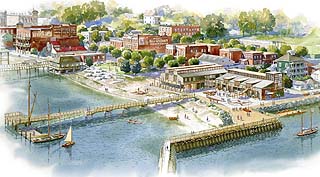
Illustration by Mike Kowalski
One of the unique requirements of the Northwest Maritime Center’s demonstration dock on Port Townsend Bay is that it can handle vessels ranging in size from historic tall ships to sea kayaks.
|
However, this goal would need to be achieved while accommodating the unique requirements of a planned educational facility. The NWMC charter called for docking visiting vessels ranging in size from historic tall ships to sea kayaks. A fleet of educational program vessels, including a variety of sailboats and rowboats, would need to be berthed at the dock during the summer months, the prime growing season for eelgrass.
An eelgrass restoration project was also planned for the site, independent of mitigation for demolishing and rebuilding the structure.
The challenges faced by the design team, however, are by no means isolated to this dock or this small Victorian seaport. Some 30,000 recreational boating slips were identified in Washington by the Department of Natural Resources’ ShoreZone Inventory in 2001. In addition, large docks are operated by the state’s ports, ferry system and industries. Taken together, the impacts of these docks are substantial on a regional scale.
Let there be light
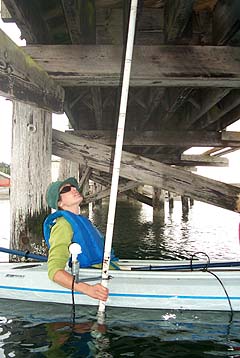
Photo courtesy of the NWMC
From a kayak underneath the NWMC dock, Heida Diefenderfer uses a meter to measure how much light is reaching potential eelgrass habitat.
|
Docks reduce nearshore eelgrass habitat directly by limiting the incident light required by these flowering plants, which is greater than that needed by macroalgae (seaweed). Docks also affect the resource indirectly, through associated activities, by means such as propeller wash and shading from vessels.
In turn, the loss of eelgrass affects Pacific herring populations, because herring deposit their eggs on blades of eelgrass during spawning. The eelgrass is also used by juvenile Dungeness crab, salmon and other species as cover and forage habitat.
The magnitude of this problem convinced the National Oceanic and Atmospheric Administration (NOAA), which has jurisdiction over the nation’s fisheries resources, to fund the NWMC’s dock design and eelgrass restoration project through its community-based habitat restoration grant program.
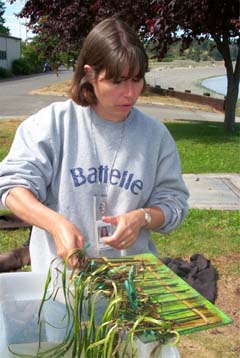
Photo courtesy of Battelle
Amy Borde, a research scientist at Battelle Marine Sciences Laboratory, prepares a tray of bundled eelgrass shoots for transplantation by divers.
|
The architect on the project is Miller/Hull and the engineer is Peratrovich, Nottingham & Drage. With the design now complete, reconstruction of the dock is planned for September 2003, and eelgrass planting is planned for May 2004.
Surveys under the dock by Battelle research divers provided the basis for decision-making related to the nearshore environment: data on the type of substrate such as sand, the location and density of eelgrass and macroalgae, and bathymetry or depth.
With maps in hand highlighting this data, the team viewed several versions of draft designs relative to their potential effects on the resources. This information also allowed researchers to estimate the extent and location of area on the site with conditions suitable for eelgrass, much as a gardener would consider soils, water and light.
The team reviewed several candidate technologies that transmit or reflect light under docks. It examined data from Battelle’s tests for the Washington State Department of Transportation (WSDOT) of a metal halide greenhouse light, SunTunnel, deck prisms, grating and glass blocks.
Also, the NWMC allowed Battelle to field-test deck prisms and a SunTunnel for WSDOT at its derelict dock, which already had holes in its decking. The data this generated on light diffusion and attenuation were specific to the site and particularly useful in the design process.
The design
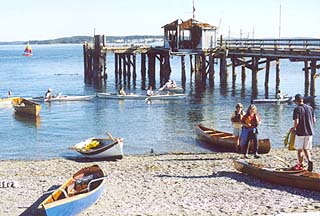
Photo courtesy of the NWMC
The derelict dock extends 230 feet into Port Townsend Bay. The design team recommended that the trestle be extended 60 feet further offshore and that the piles be converted from wood to steel to reduce impacts on the underlying marine habitat.
|
A shade model constructed for the site allowed the team to consider the relative effects of different materials and designs. Battelle calculated the expected incidence of photosynthetically active radiation, that portion of the spectrum available to plants, at the depth of eelgrass on the site under different design scenarios. These results were compared with eelgrass requirements to evaluate design alternatives.
Three key design recommendations relative to nearshore ecology evolved from the team’s work:
- To extend the dock trestle 60 feet further offshore, to 286 feet, so that the large platform at its terminus would be over water deeper than eelgrass can tolerate and also provide moorage for deeper draft vessels.
- To reduce the number of piles and associated structure and therefore shading by converting the piles from wood to steel.
- To use grating in strategic locations to reduce the potential of an abrupt light/dark barrier to fish passage.
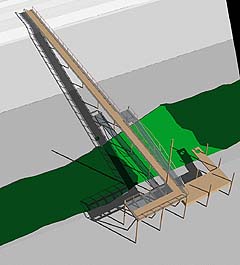
Graphic by Miller/Hull Partnership
A shade model constructed for the site allowed a committee to consider the relative effects of different dock materials and designs. The dark green areas represent existing eelgrass; the light green represents the area where eelgrass will be transplanted.
|
Ultimately, reflection was the technology selected by the team to field-test at the demonstration dock. Although this technology does not provide the greatest increase in light of those reviewed, it is the most compatible with planned uses of the dock and with the aesthetics of the Port Townsend waterfront.
Plans call for highly reflective metal panels to be affixed to stringers under the deck. This has been tested on a smaller scale under docks at the Battelle Marine Sciences Laboratory in Sequim Bay and at the Port of Anacortes. The hypothesis is that with the design changes and the light provided by reflection, eelgrass will be able to survive under the entire 11-foot-wide trestle of the new dock, whereas today there is no eelgrass in this area.
To test this hypothesis and to speed the recolonization of eelgrass, Battelle research divers will plant eelgrass in existing gaps in the spring following the dock reconstruction.
A helping hand
Under the NOAA restoration grant program, volunteers from the Port Townsend area are being recruited to help bundle eelgrass for planting. Up to 5,000 eelgrass plants, which originated at the Clinton ferry terminal on nearby Whidbey Island, will be donated from stocks maintained at Battelle for WSDOT.
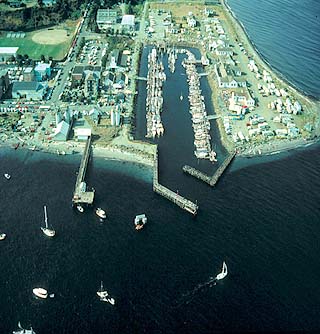
Photo courtesy of the NWMC
The site is in Port Townsend’s historic waterfront district. The pier to be rebuilt is to the left of Point Hudson Marina.
|
The Clinton ferry terminal is the site of long-running research on eelgrass transplantation. Although early eelgrass restoration efforts in the Puget Sound have had mixed results, the last five years’ work at Clinton has proven highly successful. Two reasons for this advance are increased understanding of the controlling factors on eelgrass habitat and improved planting techniques.
Long-term monitoring of transplanted and reference sites has been key to objectively evaluating and improving restoration and mitigation methods.
A similar monitoring program is planned at the NWMC site. The goal is to assess the effects of the new dock design on eelgrass and the nearshore environment. The information generated by small, directed research projects such as this one can be expected to contribute to regional restoration efforts. The Puget Sound Nearshore Ecosystem Restoration Project, for example, is currently gathering momentum to preserve and restore habitats around the Sound.
The demonstration dock is envisioned as a model for how sensitive rehabilitation of an existing overwater structure can preserve a recreational resource while compatibly allowing for a quicker recovery of the marine environment. The benefits demonstrated in this community-based habitat restoration project offers a prototype for reducing the fragmentation of nearshore habitats in the region in the context of sustainable development.
Heida Diefenderfer is a senior research scientist at the Pacific Northwest National Laboratory’s Battelle Marine Sciences Laboratory, operated by Battelle for the U.S. Department of Energy Office of Science. A biologist, Diefenderfer conducts applied research for state and federal agencies and other partners for nearshore, wetland, and watershed assessment and restoration.
Other Stories:
- Battle over keeping dams rages on
- What’s your vision for Seattle’s future?
- Hat Island gets a drink from the sea
- Foss Waterway cleanup kicks into high gear
- Reclaimed water — a ‘new’ water supply
- LOTT dives into reclaimed water
- Clean air: saving our competitive advantage
- Europe points the way to sustainability
- Old maps handy for site investigations
- Planning for an environmental emergency
- Engineered logjams: salvation for salmon
- Pierce County maps where its rivers move
- Be prepared with a spill management plan
- Development can be beneficial to wetlands
- Check out properties with microbial surveys
- Charting a sustainable course for the Sound
- Water rights no longer a hidden asset
- The economics of sustainability
- Laying the path for responsible education
- Squeezing more out of renewable energy
- Controlling mosquitos and the environment
- Beavers back in force in the Seattle area
- Our future: no time or resources to waste
- Brownfields program is here to stay
- Master Builders teaches green homebuilding
- Sculpting a park out of a brownfield
- A salmon-friendly solution on the Snake
Copyright ©2009 Seattle Daily Journal and DJC.COM.
Comments? Questions? Contact us.